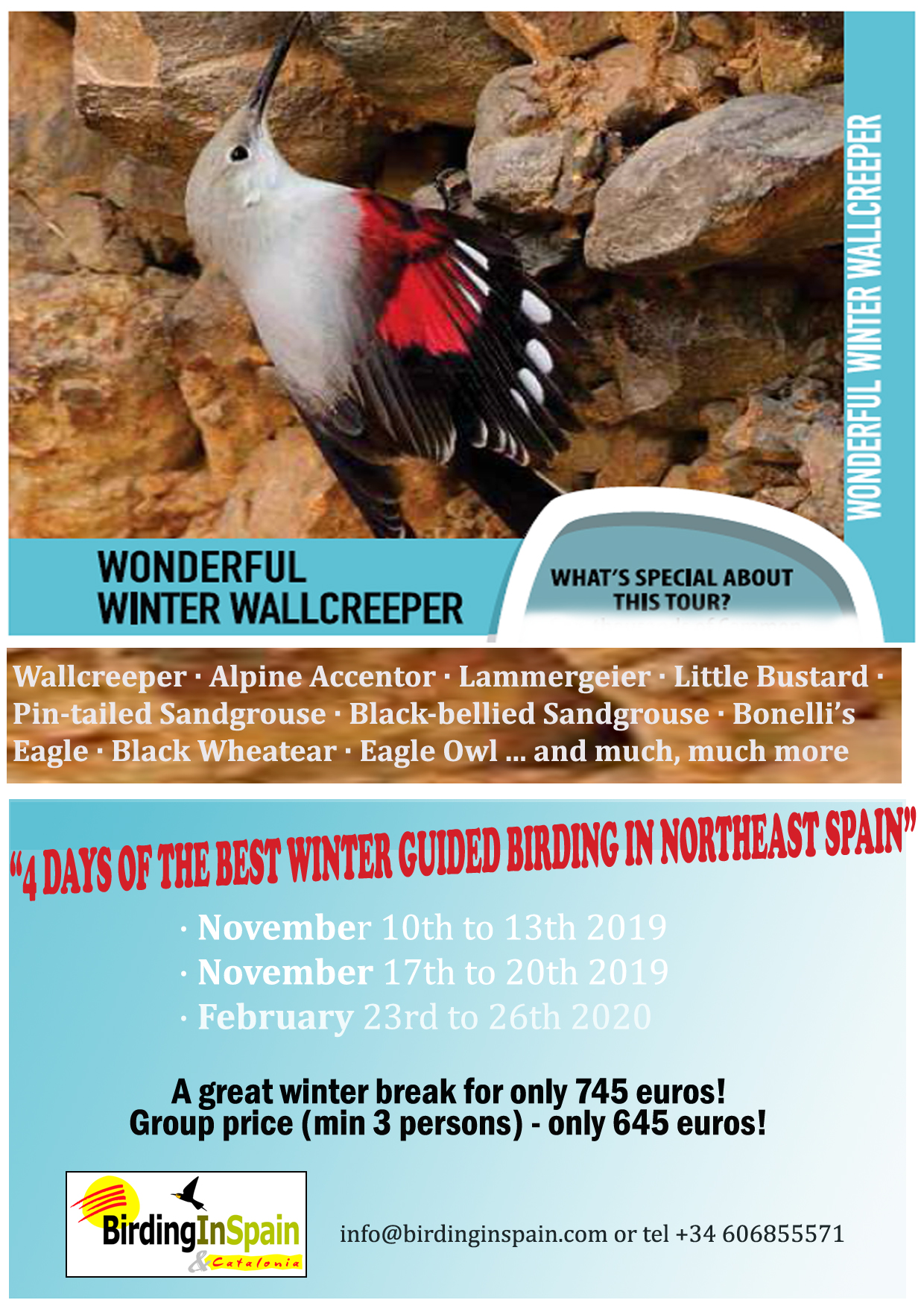Spring 2017, and the good news is that the outdoor clothing company Patagonia have conceded us one of their environmental grants to help us with our “Bovera, from brown to green” project! Our primary aim is to turn an unused field into a small haven for wildlife, whilst growing organic food and promoting nature-related leisure, education and local business.
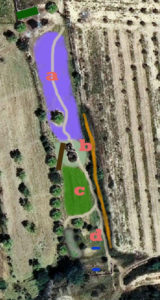
Zoning the Pou del Mano project: the original idea
a = lavendar and aromatics; b= well, chill-out area; c = vegetables; d = wildlife
One of the core premises of this project is to plant fruit trees aimed at eventually establishing a food forest, a place where fruit trees will flourish, people will enjoy the shade and picking and eating the fruit growing on the trees, birds and other wildlife will occupy and alter the new niches being created, and bushes, flowers and vegetables can be grown in the shade and open areas between the trees.
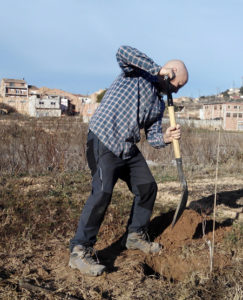
Planting a tree in Bovera
Bearing in mind that this is a harsh Mediterranean continental climate, with very low rainfall (below 400mm per year) and very high evapo-transpiration (summer maximum temperatures approach 40ºC), and that we wanted to avoid installing an irrigation system, the first task would be to select the appropriate tree species.
In the end we planted 2 or 3 of each of the following: cherry, quince, persimmon, apricot, pomegranate and fig, and half a dozen sea buckthorn. First off, the sea buckthorn were having none of it, immediately went into a sulk, and started dying. The others dragged their heels, but a quick survey 2 years later and only the original quince and the pomegranate survive.
We did our best, but obviously it wasn’t good enough. So what happened? An analysis of likely factors and explanations would be vital if we were to learn from the experience, which was our intention, rather than to give up. So as not to get too long and technical, we’ll focus on just one factor – water.
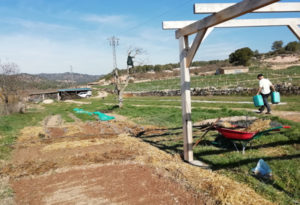
Up and down the path we go
Water and drought – even if a relatively drought resistant tree needs only 600mm of rainfall in a Mediterranean climate, when you only get between 200 and 300mm rainfall a year it doesn’t mean you can just add the extra 300 mm or so at the base of the tree (300 litres per square metre) and everything is OK. For one thing, what is the real water deficit of a particular tree in a particular area?
In other words,
(i) what is the tree’s surface area “of influence”, ie does it only extract water and nutrients from 2 or 3 square metres around the trunk?
(ii) Does the dry, unirrigated soil around that area use some of the water that you provide through capillary action, soil-dwelling organisms, invasive roots of other species?
(iii) How do you determine the most crucial moments, when the tree needs water the most?
(iv) If the temperature rises above what is “normal”, how will that affect water consumption and availability to the tree?
(v) What effect does your soil’s water retention capacity have on the ideal frequency and quantity of watering?
(vi) And what other factors can’t I think of right now?
All these are often unanswered questions that may flash through your mind as you struggle down the path with two 25-litre drums, wondering how much water to gift your trees with today.
Then when the trees start wilting you hurry to install olles (see previous Pou del Mano post). Hopes are high, they function correctly, and very soon the surrounding weeds have sent out roots to smother and command this new resource (scramble competition) before any more slow-growing competitors (trees) can get there.
But don’t despair! The new, on-site rain roof, equipped with 2,000-litre tanks and 40 m2 of rain-catching surface will spare us from having to use the mains water, even if we do have to continue watering by hand. If only it would rain. And then … it rains in November, when the trees that have survived the summer won’t thank you for your contributions.
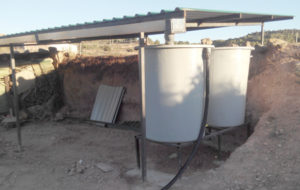
The rain roof and water tanks
So then, your pride around your ankles, you turn to irrigation, just like everybody else. The lessons of life and living.
We recommend
Iceland Awakes! An awesome spring tour.
A real client review
“In September 2018, together with my non birding son, I went on a 10 day tour of Iceland led by Steve West of Birding in Spain. Steve worked tirelessly to find the birds and we had a very successful birding trip. He also managed to incorporate all the important ‘tourist sites’ and general wildlife into our trip. A very successful tour on a magical island that catered for everyone. We even got the Northern Lights. This was my third birding trip with Steve, he remains my first choice for guided trips.” – Ian, UK.
Next: Where have all the swallows gone?
The frog in the well
The frog in the well
A puzzle for you:
- A frog is at the bottom of a well, which is 30 feet deep (use metres if you prefer). Every day the frog climbs up 3 feet (or metres), but slides back 2. How many days will the frog need to get out of the well?
You can answer in the comments section if you think you have it. Or if you prefer, send us an e-mail.
We’re still waiting for a frog to appear, not in the well, but in the pool. So far, no frog, although we did have a whopping toad for one day. On another day, as I was filling an “olla” with water I was delighted to discover a small frog avidly swimming about inside. I let it crawl out of the top hole as I filled the olla, and didn’t replace the stone over the top of the hole, as I felt certain it would like to go back in sooner or later. That in itself gave me an idea: why not create “micro-reserves” with olles here and there, some with water and some without? Those without water would be refuges for spiders, beetles and woodlice, while those with might be encouragement for more froglets.
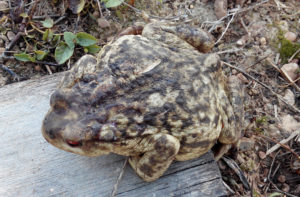
Common Toad, Bufo bufo
You can read more about “olles” here, including their function in permaculture, and how to make a terra cotta flowerpot olla:
https://wateruseitwisely.com/olla-irrigation/
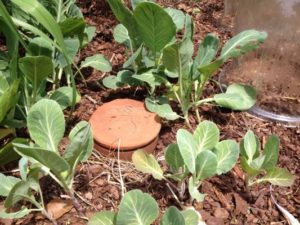
Home-made olla for watering
Like many of the gardening tasks, such as weeding, planting and the like, filling and inspecting ollas requires a fair bit of bending over. However, when bent over I don’t have to raise my head to know that one of the local Blue Tits is close, this time inspecting the nest box that I’ve put up for them on the dying persimonn tree. Last year they built a nest, but for some reason they abandoned before any eggs were laid. When I ascended to clean out the nest box there was the nest, but none of the dirt associated with a used one. I think the problem is that they are of a very nervous disposition and cannot accept my presence, even when I’m face down and bent over most of the time and only watch them through the corner of my eye!
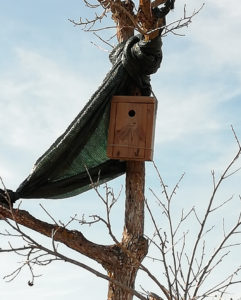
Blue Tit nest box on persimmon tree
This year they haven’t nested, despite repeated attempts by the male to encourage the female to have a look around the lovely new residence he had discovered. I think she took a dislike to the neighbours (me) and that hers was the final word. Even the shading I had put up for the box to compensate for the lack of branches and leaves was not good enough for her more refined tastes.
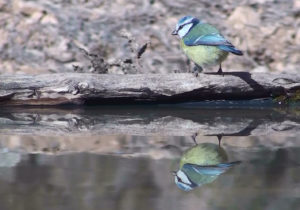
Blue Tit, Cyanistes caeruleus, at drinking pool
If you are thinking about making, purchasing and erecting a nest box for hole nesting birds such as the Blue Tit, or indeed even a considerable array of other potential birds, you really should read up well to maximize the possibilities of success. You could do much worse than to buy this book published by the BTO (British Trust for Ornithology)
https://www.bto.org/our-science/publications/bto-books-and-guides/nestboxes-your-complete-guide
At the Pou del Mano I haven’t seen much evidence of nesting birds. Certainly early in the spring we had a Corn Bunting singing almost non-stop for weeks above and around the couple of hay bales which we use for mulch, and more or less at the same time two male Sardinian Warblers were in avid pursuit of a female Sardinian Warbler. The Black Redstarts that frequented the rain roof throughout the winter were no longer there one day in mid-spring, while the singing Hoopoe from last year seems to have moved elsewhere. Golden Orioles nest in trees close to us, but not on site, and the Stone Curlew has been in fields close by for the last two breeding seasons. On the upside we’re getting a lot of interest from this year’s Little Owl juveniles, exploring the area close to where they were born, while doing their best to avoid the couple of marauding cats we try to keep off the site. A Black-eared Wheatear puts in the occasional appearance, and this year the Red-rumped Swallows seem to be a little less common than in previous years.
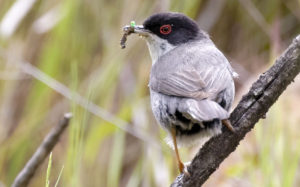
Male Sardinian Warbler, Sylvia melanocephala
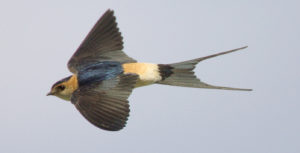
Red-rumped Swallow, Cecropis daurica
But back to the frog in the well: the Pou del Mano is actually 13 metres deep, so how long would the above-mentioned frog need to get out of the well?
Next chapter: Tree planting – dreams and realities
BIS feedback, what real people say about us
Bill W., UK, May 2019
Unlike some of the others on the trip, this was my first time birding in another country, and I thoroughly enjoyed the whole experience. However, the fact that it was so enjoyable was undoubtedly due to being in the company of you both. From the moment you picked us up from the airport, we knew we were in good hands.
Your bird knowledge Steve, I found to be extraordinary, and I would never have seen my 52 “lifers” without your help.
Also, many thanks to you both for your help with Spanish translation and pronunciation. I am now seriously considering looking for a local Spanish conversation class.
All the very best to you both, and I hope we get the opportunity to meet again in the not too distant future.
Thanks Bill!
We recommend:
Iceland awakes! An awesome spring birding tour
Tell us about the birds and the bees
The birds and the bees, mmm, I think we’ll start off literally and see where it leads.
Alas, the canvas hide overlooking the pool has stood unloved for a couple of years now, if occupation for any nature-oriented purpose is anything to measure love by. In other words, I have had no time to spend in the hide enjoying some of the fruits of my many labours, and it’s a shame. It happens like this: before I can walk the 200 metres or so between my parked car and the pool there are just so many things that I see need attending to and I have so many ideas about what could be done that I can never quite make it.
For example:
• The compost isn’t doing anything – you could turn and water it.
• Check on how the trees are doing – water, aphids, nutrients…
• Turn over a log or move a branch in the wood pile to see if anything moves
• The stairs up to the pool need weeding/repairing
• Weeding, there is always weeding to do. But are there enough edible weeds to gather and make them into a dish?
• Check to see if any of the flower seed is showing signs of life.
• Scythe the grass
• Improve the paths
And so on, and so on, and so…
Thankfully, in my prolonged absence we have the trail cam to step into my shoes, and to at least bear witness to some of what goes on at the pool. With it’s motion detection and nocturnal flash function it’s the unsleeping eye – as long as the batteries last, and as long as it’s aligned properly.
How else would we have discovered that a Red Fox is a regular visitor to the pool, at night, and even at 9 in the morning? Or that Badgers are in the area, and visit when all is dark and still? And that at last those couple of stray tick-infested dogs seem to have moved on?
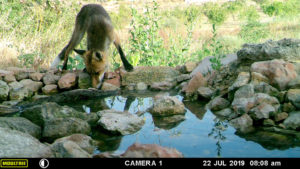
Red Fox at the Pou del Mano drinking pool
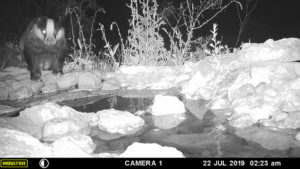
Badger at the Pou del Mano drinking pool
Having said “badger” reminds me of a badge I used to wear at Sixth-form college, when I was an active member of Friends of the Earth and Greenpeace, trying to get people interested in saving the world’s wildlife. It read “Don’t badger the badger”, which in itself is quite a succinct endorsement of the English language ie “badger” can be used as a verb as well as a noun and slots perfectly into a 4-word catchword to convey the message: “Leave the badgers alone, they are not your scapegoats”. Unfortunately there’s no trace of the badge among my personal belongings, and worse yet, I can’t even trace it on the Internet. Has anyone out there ever had one of those badges, and still got it? If so, I’d love to hear from you.
It seems the idea of slaughtering badgers (called “culling” when you have to justify it to constituents or customers) resurfaces every decade or so in the UK, as in its day my old badge was a response to ongoing badger culls in the early 1980s, while the Guardian article below relates to a proposed cull in 2010.
https://www.theguardian.com/environment/blog/2011/aug/11/badger-cull-dont-stop-bovine-tb
By the way, if you read the article it virtually destroys the logic of any proposed badger slaughter, and please let’s not get started on “Seals eat our fish”, and “Fox-hunting is needed to control the vermin”, and all that kind of nonsense.
Back to the camera: more than 30 species of birds were recorded in the first couple of winter sessions, including the locally scarce Brambling and Hawfinch. Unfortunately, the camera wasn’t set for the spring migration, when I was hearing regular bursts of song from Wryneck, Bonelli’s Warbler and even Grasshopper Warbler. Hopefully next year…
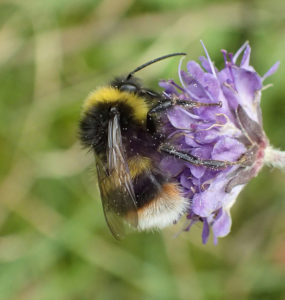
Bumble bee on flower
And the bees? Well, one of the measures that you can take to encourage native bees is to provide water for them. They need nectar and pollen sources, soft banks to nest or roost in, patches of exposed earth and water. Although the hard truth is that we’ve had more interest at the pool from wasps and even dragonflies than from bees, it’s still early days yet, and once the drought has come to an end hopefully much of the flower seed we have sown will grow into flowers, attracting bees who will then need a drink after gorging themselves on abundant nectar. Either way, we’re going to have a lot to say about bees …
Next chapter: The frog in the well
What real people say about Birding In Spain:
Julie and Roger Knourek (USA), Marvellous May 2019
Hello Steve and Florinda! We’re back in Arizona, rested up and ready to travel to Wyoming for the rest of the summer. I just wanted to take a minute to thank you for the Marvelous May trip we recently went on with you. Everything worked out perfectly – the birding was excellent, the hotels and food were wonderful, and we enjoyed everyone’s friendship and companionship while we were on the tour. I really appreciate that you were able to accommodate our needs when necessary. It was truly one of the highlights of our lives!!! I will post a few pictures when we get to WY and get settled in. Thanks so much!
We recommend:
Marvellous May Scotland Tour 2020
- information to follow
The drinking pool’s conception was easy enough, it’s being a parent of a thirsty and difficult pool progeny that’s the hard work!
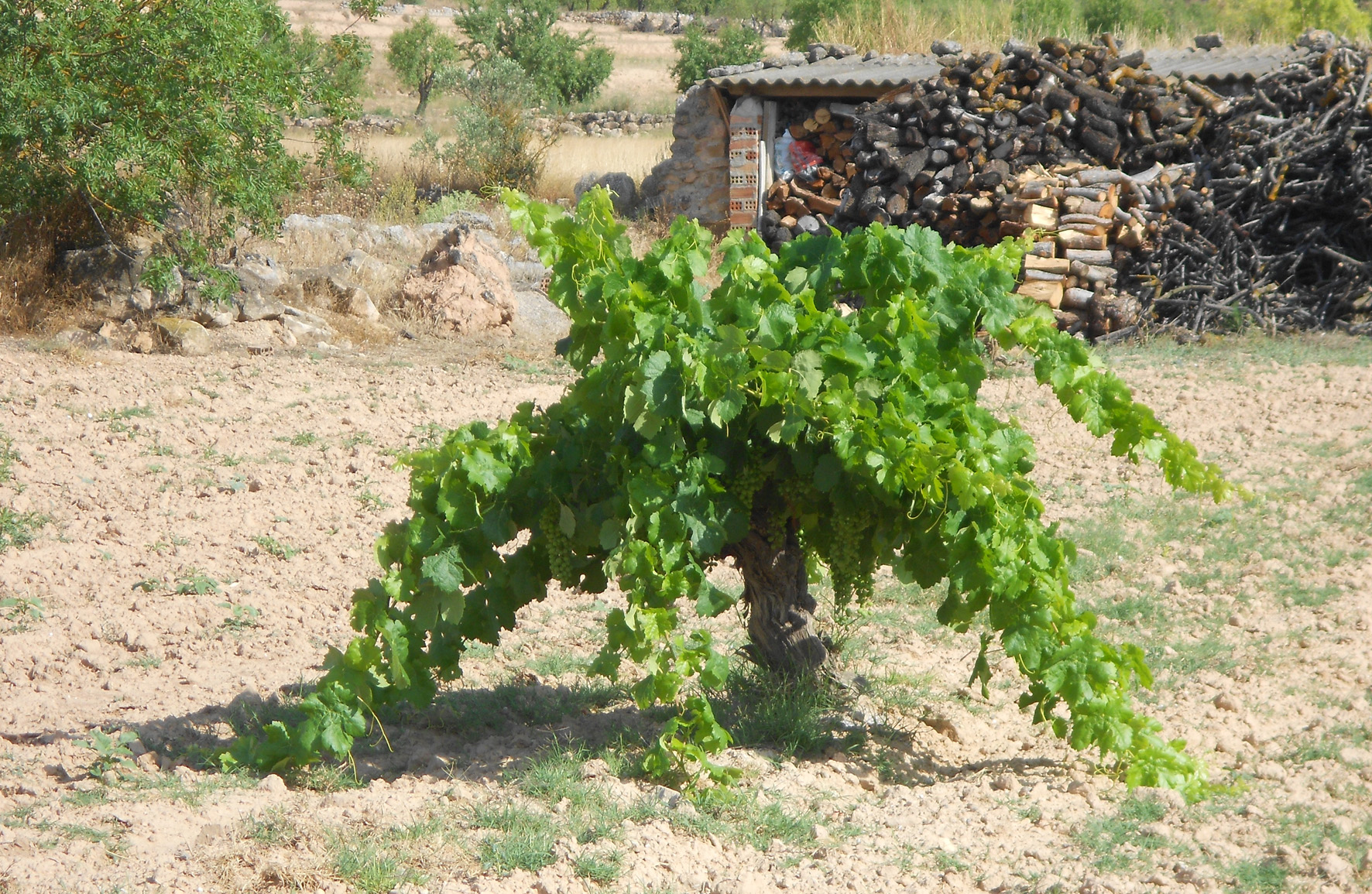
Heard it through the grapevine
Until we proposed the drinking-pool as a reality brother-in-law Jordi would come to the “Pou” with the tractor and plough the weeds a couple of times a year, and someone in the family would casually pick some of the bunches of grapes produced by decades-old grapevines. Occasionally, villagers may have visited and poked around the stone walls and fennel plants, looking for snails after a bit of rain – yes, we eat snails, and they are the same as the ones that many people poison in their gardens in the UK. What a waste! They are just delicious griddled and dipped in garlic butter!
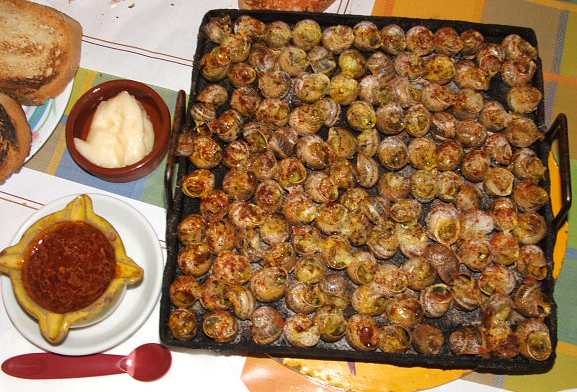
Cargols a la llauna, Lleida
Here’s a recipe for that very “Lleidatà” (from Lleida) dish, with garlic butter, salt, pepper … mmm, delicious!
But back to the drinking pool and some of the initial considerations in its imperfect design.
- Location: It should be away from human transit and hence disturbance, which narrowed down the possibilities to the far end of the plot. Uncertainty about the future use of the continuous flat area led me to site the pool in the vicinity of the big Holm Oak tree, on the small terraced slope. This choice would have consequences which will be dealt with later.
- Dimensions: The pool, for the time being at least, would have to be filled by hand. I had already learnt from previous experiences with larger pools that that in itself could be an onerous and thankless task, difficult to keep up with in the summer, when water is most needed by the birds and other wildlife. So the pool wasn’t going to be so big that it couldn’t be filled by two or three trips with a wheelbarrow laden with 25 litre water containers. However, it also had to have some depth to ensure that summer evaporation would not dry it out in no time at all.
- Shape: The final figure of 8 shape seems quirky at first sight, but makes it possible to retain at least some water in case of leakage or low refilling frequency by damming the “waist” if needed and dedicating the meagre water resources to only half of the pool.
- Construction: Dig a hole to the right depth and shape, flatten and smooth the surface, remove any sharp objects, cover with old clothes, sheets, blankets, carpets – whatever – roll out the liner, cut to measure, leaving overlap around the edges, make a ledge and fold over the edges, get some rocks and stones to weigh it down.
- Aesthetics: We used stones to overlay the edges of the liner, as there were plenty of those about. We also used burlap, but that disintegrated before too long. Leaves and other debris get in the cracks between the stones, so it’s probably best to cement them in. We also had a supply of pebbly stones which were ideal for lining the bottom of the pool.*
- Aeration: Little solar-powered aerators (made in China) seem like a good idea, but don’t have much impact and don’t last for more than one season. Think seriously about this and mosquitoes if you are in a hot climate. For us the eventual solution was to link the pool to the irrigation system and have a “jet” of water aerating the surface whenever we turn on the tap.
- Stability: The slopes needed stabilizing, and also people walking around the edges have to be catered for. Reeds cut from the field edge (see photo) were remarkably effective in preventing slope erosion over what was very loose soil on quite a steep slope.
- If you’re going to plant then the plants will need some attention. Winter shade and freezing temperatures just about polish off the plants that manage to survive the extreme heat of the summer. We’re still working on this.
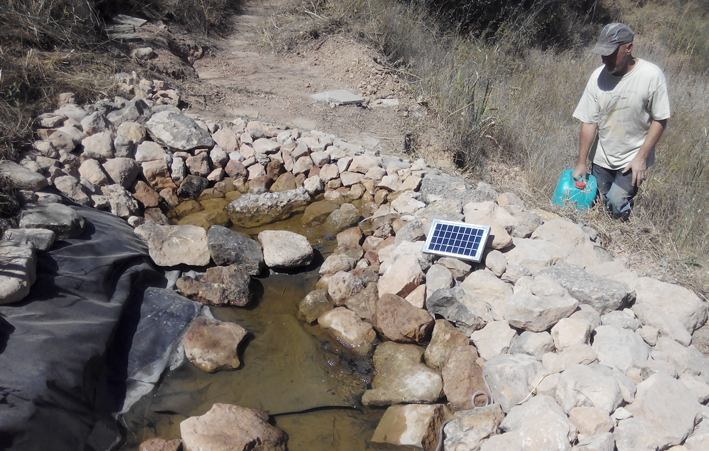
For the birds: filling the drinking pool
* The pebbles were left in a heap by Florinda’s grandfather about 40 years previously. He was too old to do heavy work on the land so spent his time removing pebbles from the ground one by one and discarding them on a pile next to the well.
That’s a lot of work, when do we start reaping the rewards? And where are the birds?
Next: Tell us about the birds and the bees
What real people say about Birding In Spain :
Jeremy Bradshaw (Liverpool, UK) – Marvellous May Tour 2019
We’ve just come back from a fantastic 7 days “Marvellous May” birding trip with Steve and Florinda in NE Spain. From our first contact to our final goodbyes at the airport, we were treated with friendly professionalism. Steve’s knowledge of bird identification is outstanding (particularly his identification by call) and his brilliant local knowledge of good bird sites enabled us to “tot up” a trip list of over 190 species including some difficult and much sought after birds, such as Dupont’s Lark, Sandgrouse and Alpine Accentor to name but a few. The hotel accommodation, in all three locations we visited, were well run and friendly with good food and well stocked bars! Would I recommend using BirdinginSpain and Steve for a guided birdwatching holiday? Yes, in a heart beat ! “
We recommend …
El Pou del Mano
Note: The translation of the title “Pou del Mano” from Catalan to English is “Mano’s Well”. “Mano” is the village nick-name of Florinda’s parents’ household, for this generation mostly applied to Salvador, Florinda’s father.
Bovera, Les Garrigues, Catalonia.
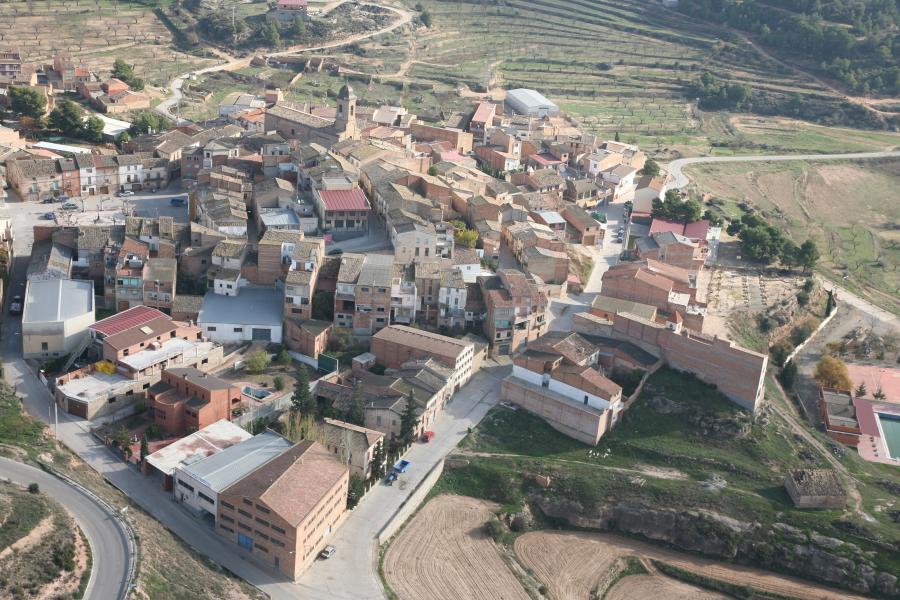
The village of Bovera in the Garrigues, Catalonia
A new chapter has opened in our lives, and it’s taking on ever increasing dimensions. In July 2016 things kicked off with my idea of building a small drinking pool for birds, down near the “pou” (well). The smallish plot, about 2,000m², once held apple and peach trees, which Salvador, my father-in-law, used to irrigate from the water he drew from a well in the middle of the plot . Rather tentatively I put the idea to Salvador and, fortunately, he had no reservations, “Do what you like with it”, he said. Even though the land had lain idle for about 30 years, after he had uprooted the drought-stricken trees, it was still a relief to me to hear those words, as I still felt like an outsider on most things related to Florinda’s village. Little by little though, the initial project would expand and take on new dimensions and provide a source of new endeavours, and some disappointments and headaches too.
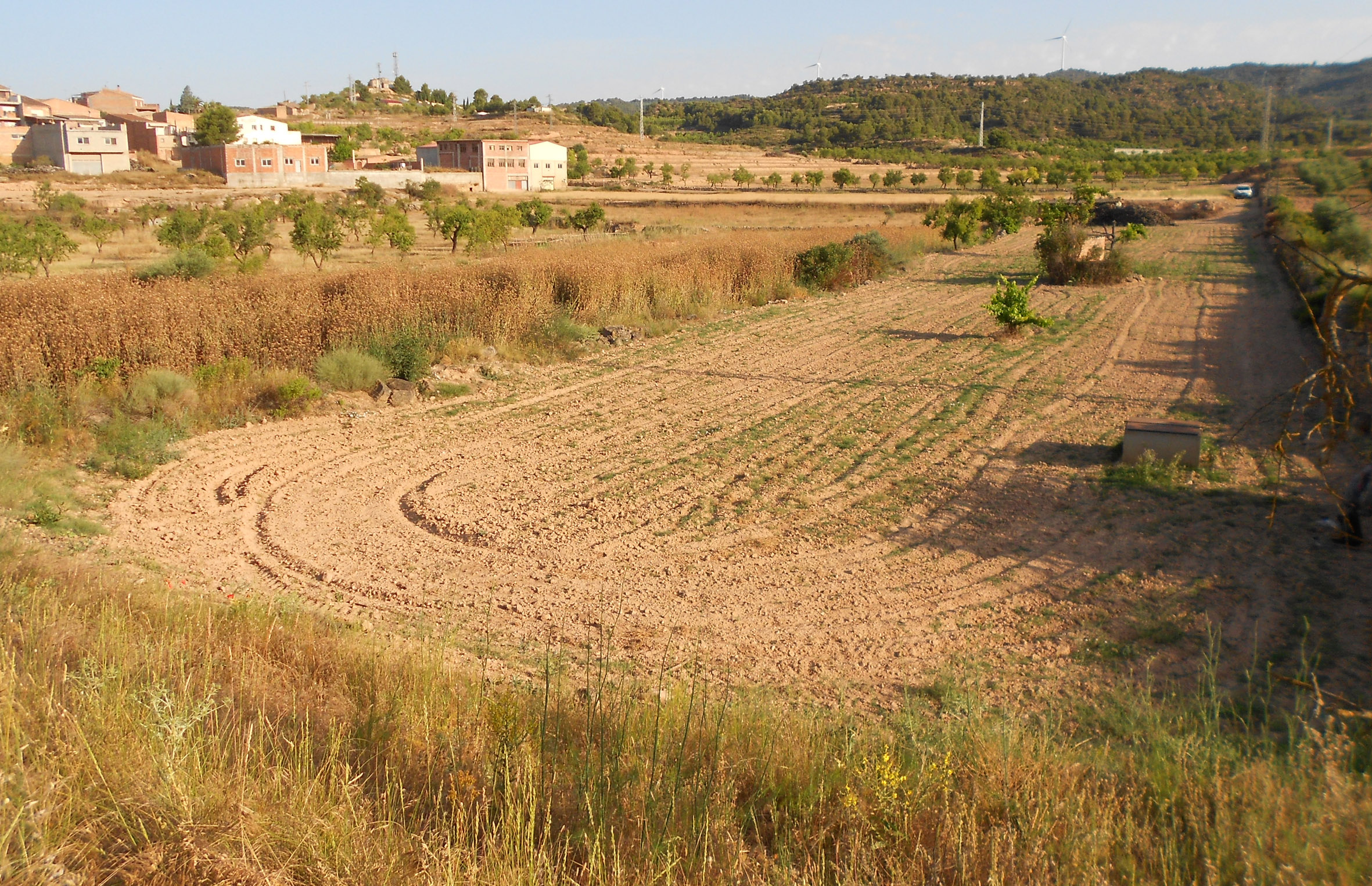
The view towards the well – centre – and Bovera village – left
So, once in place with all the necessary materials for building a modest drinking pool – a roll of heavy duty black plastic liner, old discarded clothes, burlap (bought on the internet and sent from India), cutter, spade, pick-axe, hoe, string, tape measure – I was alone before the beast of doubt. What shape should the pool take? How deep? How would I stabilize the margins? Should I try and incorporate plants? Is there any need for an overflow? And so on.
Well, here are some photos from that very first day (and later), when there were more doubts than realities.
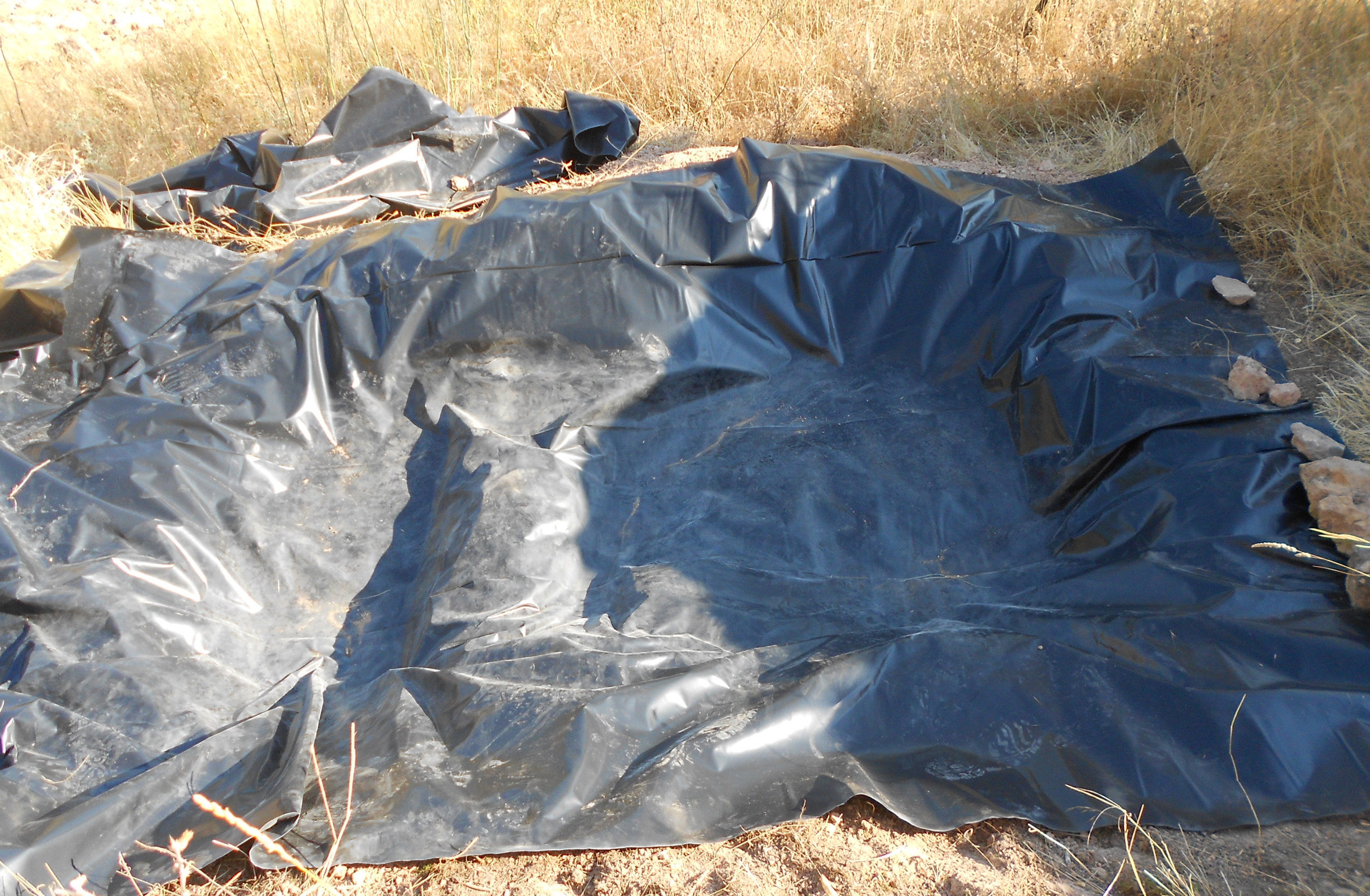
New drinking pool in the making I
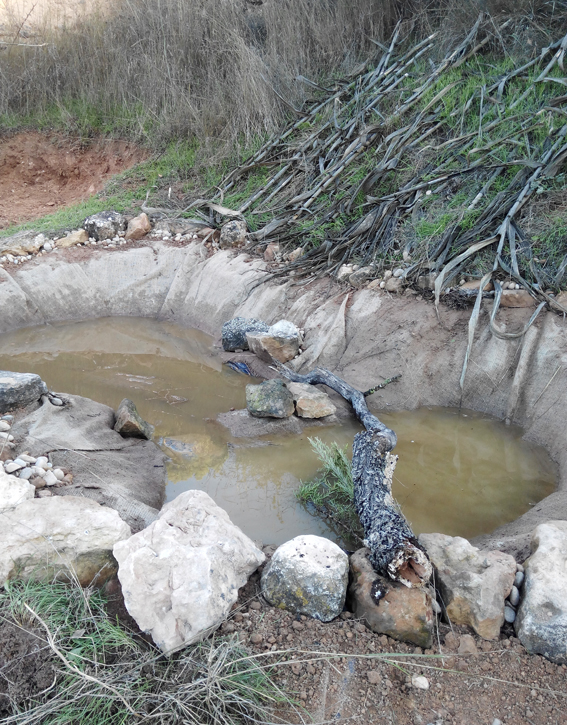
New drinking pool in the making II
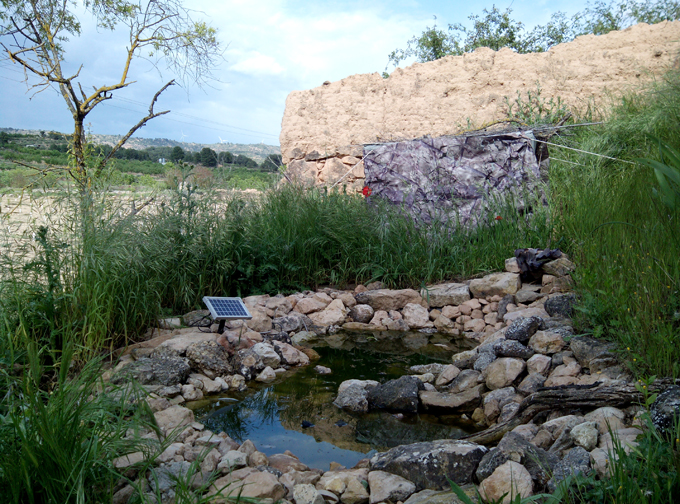
New drinking pool in the making – the finished product?
That was almost three years ago. In that time the pool has been a focal point for much of the local wildlife, in particular birds, but also the odd toad, timid nocturnal badgers, foxes and stray dogs, dragonflies, bees and wasps, and mosquitoes. Damn the mosquitoes.
I also set up a hide, rescued from the days when we dealt directly with international photographers on the Lleida plains, coming to photograph Little Bustards, Little Owls, Stone Curlews and the like. However, after two years of accustomization the birds are fine with it, but I have yet to find the time to get in there and take some photos or videos! The trail cam, however, did much of the job for me, and after the first session of going through about 2,000 photos I proudly declared that we had already had 30 species of avian visitors to the pool, and that was even before the spring migration period had started. At that time Hawfinches were everywhere, and the pool was no exception, but the camera also recorded one of only two records of Brambling for the village, this one a fine male coming out of winter plumage. However, for me the most enjoyable scenes were the starlings, both Spotless and Common, which made a regular appointment in the early afternoon, to come down, drink, bathe and socialize in groups of 5, 10, 20 or more, before continuing the party by flying off to the roofs and the village church for the end of the day chatter and sing-song.
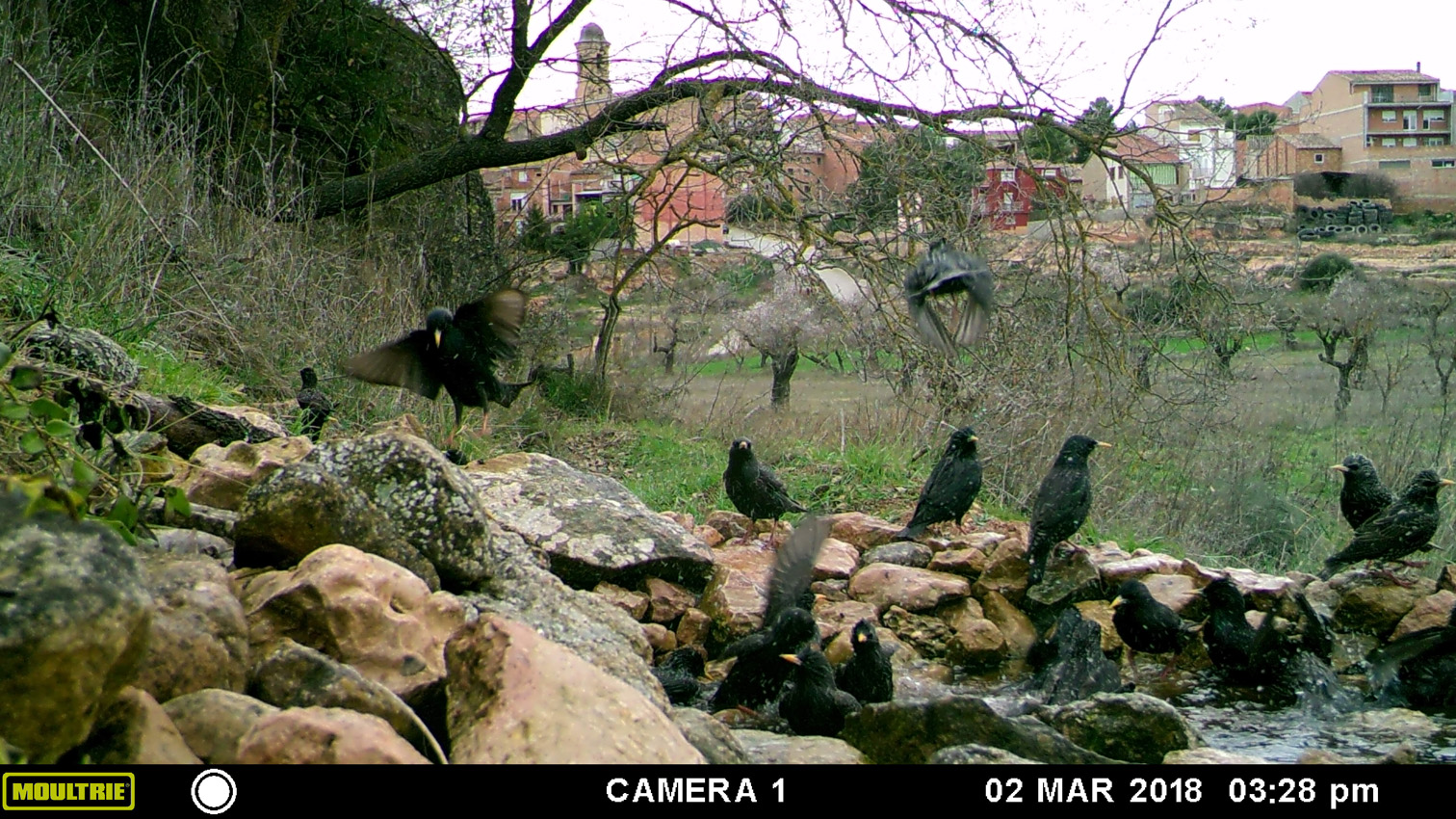
Starling festival at Bovera I
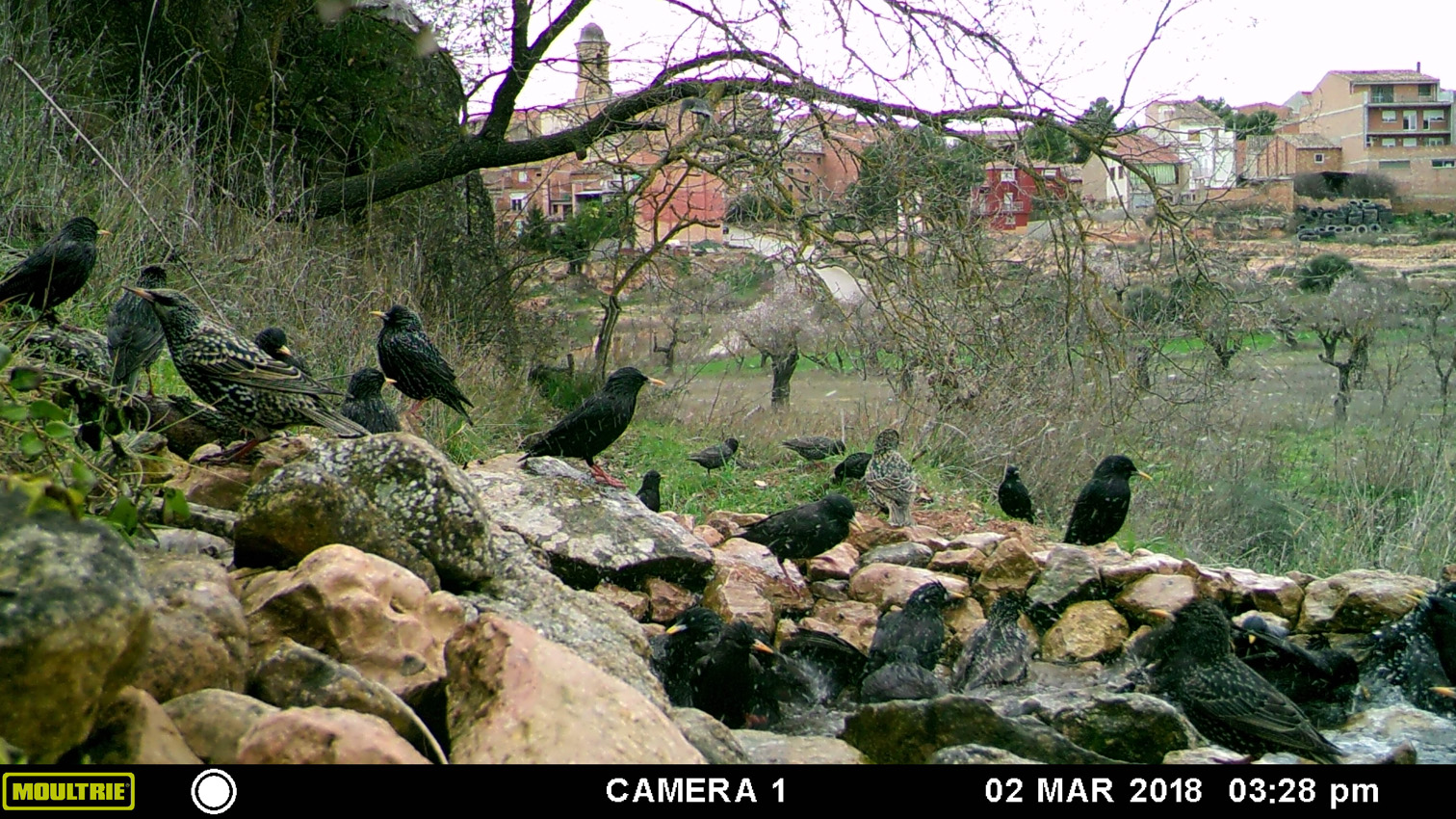
Starling festival at Bovera II
Next post: Figures of 8 – Pool-making considerations for humans
About the Birding In Spain Gift Pack now available:
Looking for a Christmas gift that will leave the loved one(s) open-mouthed with delight?
You must know that birders already have bird books, binoculars and apps, but that nobody – even the most experienced birder – has travelled the whole world and seen all of its birds and natural wonders.
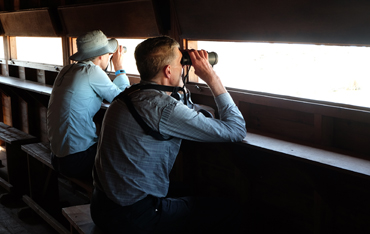
Two birding together
Have they ever been birding in Spain? If not, can you think of a better way to make them a gift that they’ll enjoy and remember for a long time?
Birding In Spain is easy, safe and really enjoyable. Here’s how to do it:
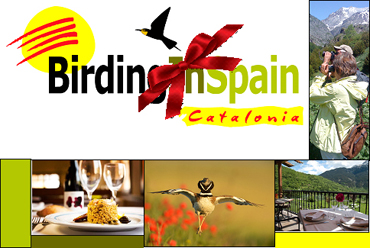
Birding In Spain gift card
- Look at the website, and download our brochure to see what kind of tours we put on offer, who we are, etc.
- Decide if you want to participate in one of the set tours, or if you want us to design a private tour for you.
- Decide how much you want to spend on your gift for now. The minimum of 50 euros won’t buy you a tour but it will ensure you a provisional place on one until all the details have been arranged and confirmed.
- Send us all the the details you can about yourselves, approximate dates, tour interest, etc, as well as what text and details you would like us to incorporate on the personalized gift card.
- Birding In Spain Gift Pack Special! Purchase before 31st December 2018 and enjoy a 5% discount from the brochure price from any set tour, and a bottle of local wine or cava during your tour.
- Receive your personalized gift card from us. It’s a guarantee of our compromise with you. Merry Christmas!
The total number of wild birds in the world is somewhere between 100 and 400 billion according to an article published by Arbotopia. The fact that they are all around us in so many different shapes, colours and sizes is perhaps what makes them so fascinating. The migratory patterns of some birds or the peculiar habitats of others has spawned an interest in bird tourism. Going on a holiday in a bird hotspot, such as Northeast Spain, is decidedly attractive, but it’s also possible to create a home to many intriguing birds in your own garden.
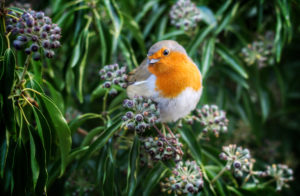
Robins in your garden, photo by Andrew Alexander
Feed them
Birds have an eye for a tasty morsel and having flown thousands of miles in some cases will want to stop where it is safe and where they find food waiting for them. Furthermore, researchers believe feeding birds encourages flight patterns causing birds like the Blackcap to settle in the UK instead of going to Spain. With that said, you could try feeding them mealworms, as well as bits of fruit or peanuts to make the stay.
Give them a drink
Water is essential to birds. Not only to drink but also for the all important grooming of feathers and even for entertainment. They tend to be drawn to water in motion. If you want to attract a large variety of birds then you should consider a water feature. Keep it usable all year round by placing rocks in it to prevent the water freezing over and installing a solar powered version will make it conservation friendly. The Cuckoo and the Woodpeckers, although generally shy birds would both appreciate being offered a drink from the fountain.
Give them a shelter
The garden environment should also be considered as it is a shame to invite birds into the garden only to find that they are at risk from predators or the food on offer is being eaten by other animals. Consider where the food is being placed in order to attract a variety of birds. Even if you are not ready to completely redesign your garden you might be prepared to leave that old tree stump in place to accommodate a Woodpecker, or not cut back your bushes quite so neatly, and allow the Blackcap to roost there.
Birds are everywhere and there are many species worth exploring, particularly in Spain. But if you are concerned about your ‘ carbon footprint’ there is a lot you can do to attract birds to your garden and conserve the bird population.
Article by guest writer Sally Writes.
Poble Style Birding 1
Making a pool for birds
“Making a small drinking pool to attract birds to your garden is such an easy thing to do! Just make a hole in the ground, line it with plastic, and fill it with water.”
“Then you can enjoy watching the birds coming down to drink or bathe at your own conveniece – Just imagine: Cirl Buntings, Hawfinches, Nightingales, Rock Sparrows, Blackbirds, Chiffchaffs, Chaffinches, Robins, Dunnocks, and so much more…”
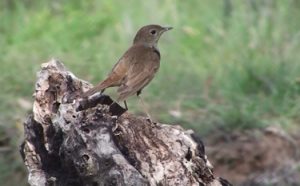
Nightingale
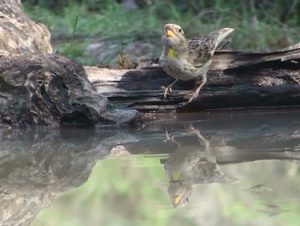
Rock Sparrow
Wait a minute – Cut! Cut! Before we continue with this script from “Brave New World” or whatever, there are some hard realities to take into account when you’re hands-on with a drinking pool. For example:
- Stabilize the banks – you’ve dug out all that earth, on a slope, and you’ve just realized that at the first drop of rain it will become a mudslide collapsing into your beautifully crafted pond.
- Plant plants around the edge, and try to keep them alive despite drought, frost, herbivores, trampling, etc.
- Deal with a leak without giving up. Undo your craftmanship and start all over again.
- Keep the pool topped up, in the heat of the summer when water seems to evaporate almost faster than you can pour it in, and when you go on holiday for a couple of weeks to get away from it all
- Deal with the overflow from the sheep farm at the top of the slope seeping into your pool and turning it all into a foul-smelling sludge.
- Remove leaves and debris from the cold water and between the stones you laid out to make it look nice.
- Combat the mosquitoes that see your little pool as their promised land.
- Keep out unwanted mammals – boars, rats, hunters.
- Aerate the water
- Patiently replenish the water after every visit by a wintering flock of some 2,000 starlings, which have descended on it for a bath, a drink and their social event of the week.
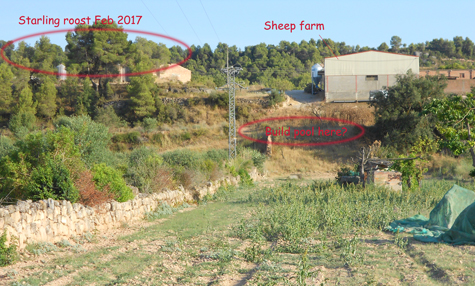
Are you sure you’ve got a good site?
Then and only then might you get Hawfinches, Sparrows, Chaffinches, Black Redstarts, Chiffchaffs, Robins, Blackbirds, and even Starlings. Enjoy!
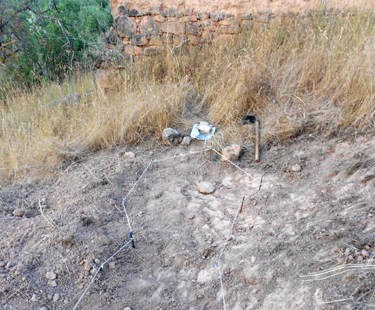
Getting started
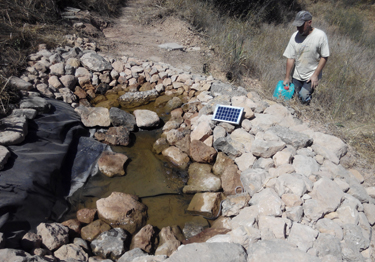
Almost finished (again). Stones, aerator, water feeder.
Collins Bird Guide App, a review of sorts.
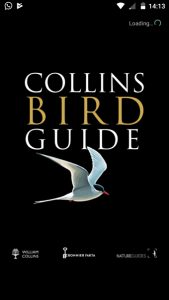
Years ago, when we got married, my wife’s work colleagues at the time made us a gift of a new microwave oven. This was back in the early 1990s, when not everyone had a microwave, and well before the era of mobile phones. True to my luddite streak, in private, I rather ungratefully declared “Who needs a microwave”? Because if I wanted to boil milk I used a saucepan, I had the kettle for boiling water, cooking was done in the oven, and defrosting food was planned the night before.
I’ve mellowed somewhat over the years, at least that’s what my wife tells me now and then; even so, I must admit I was tempted to say, “Who needs the Collins Bird Guide as an app?”. Now I’ve always said that the Collins Bird Guide – in its traditional paper and ink form – would remain unsurpassed by any similar field guide for decades to come, and I feel that that particular statement has the ring of truth, unless we get pedantic and count second and third editions etc.
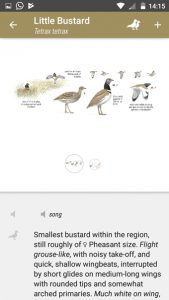
Collins Bird Guide Little Bustard
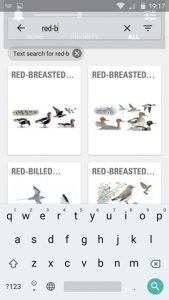
Collins Bird Guide App search feature
So I have the Collins Bird Guide if I want to see an illustration of the species itself, see the bird in its natural habitat, glance at a distribution map with colours for winter, summer etc, read a useful descriptive text, or even have a description of the bird’s song and calls. What more could I need? And, furthermore, how could an app replace the feeling of leafing through a bird book?
Well, what I didn’t realize is that it doesn’t need to replace anything, rather this app has made a niche for itself and is ideal for anybody who is out and about birding in Europe, and even more so if you happen to be a professional of the birding world. The book is still there for you on the shelf, perhaps in the car or at best in the backpack, although if you have the app on your mobile phone then you might as well save yourself the inconvenience of the latter.
This app does everything the book does, as you’d expect, and without getting dog-eared, but what else can it do? Well, the list is quite substantial:
(i) Instant alphabetical search function – just type in the name of the bird species and the options appear as you write. Of course this is a commonsense feature, but just think of any beginner birders you may know and the difficulties they have finding their way through the standard guide, “Why aren’t the birds in alphabetical order?” is a question I have often been asked.
(ii) Comparison feature allowing the user to compare similar species or any species they want, up to 6 in all – even if you think Crested Larks and Hoopoes both have a crest and so need to be compared the app will not put up any obstacles or raise any objections.
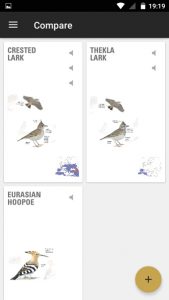
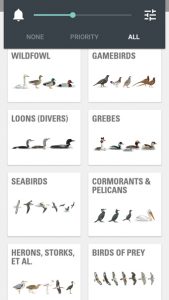
(iii) Recordings of most species’ songs and calls – making redundant the very variable interpretations of the phonetics of descriptions such as “voy voy…vüüü(cha)… vüüü(cha) swe-swe-swe-swe-swe sisisi … svee, sveeh” (can you tell me which species that refers to off the top of your head?). Just play the call (looped) and there is no need for any words to get in the way – however, they’re still in the text if you’re a fan.
(iv) The “My list” feature offers you a simple note-taking capacity. Admittedly, I personally still prefer the written notebook, but that may change.
(v) Add-to (and pay-for) features already available or nearly so include Bird Atlas 2007-11 maps if you have a special interest in Britain and Ireland, and species videos, many of which are brand new and have been filmed especially for this app.
In summary, in the field this all this translates to:
What does the bird look like? That.
What does it sound like? That.
What’s its range in Europe? That.
How is it different from a Hoopoe? There.
OK, so having established that this app is the best thing to happen to European birding since the Collins Bird Guide was published, is there anything the app doesn’t do, and perhaps could? Well, I miss a bit of “fun”, for example a quiz option where you can challenge your buddies or students to identify the species from the song (fingers on the buzzer or not) or the distribution map, or even “bits” of the bird in question. Furthermore, some of the recordings are of below average quality, although I have been informed that this is a shortfall which is likely to be rectified in later editions. Another thing is that, as with any app, it’s not as easy to lend as a book is. Come to think of it, that’s got to be an advantage.
The Collins Bird Guide app or, “Who needs a microwave?”. I do!

